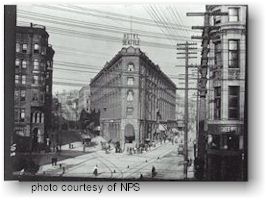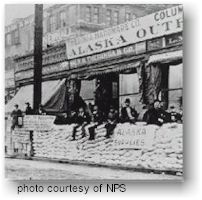


|

|
 |
 |
| Description
In 1897 news of a gold strike in the Canadian Yukon reached Seattle, triggering a stampede North to the Klondike Gold Fields. From 1897 to 1898, tens of thousands of people from across the United States and around the world descended upon Seattle's commercial district. While in Seattle, the hopeful miners purchased millions of dollars of food, clothing, equipment, pack animals, and steamship tickets. The final outcome of this great stampede helped shape the Seattle we know today, bolstering the city's reputation as the Queen City of the Pacific Northwest. |
Park Information
Hours/Seasons: The Seattle unit of Klondike Gold Rush National Historical Park is open daily from 9:00 am to 5:00 pm. The park is closed Thanksgiving, Christmas, and New Year's Day. Directions: Take the James Street exit from I-5. Proceed down the hill and turn left at Second Avenue, then veer right onto S. Washington Street. Street parking is available, but difficult to find during business hours; parking meters are free on Sundays and major holidays. Public parking lots can be found throughout the neighborhood. Fees: Free! Weather: Seattle has a marine-type climate. Winters are cool, and summers are mild and pleasant. The average annual temperature is 53 degrees, with an average low of 36 degrees in the winter and an average high of 69 degrees in the summer. The average annual rain fall is 39 inches, with 100 rain free days per year, and an average of 49 percent sunshine during the daylight hours. |
|
|
History
Many stampeders arrived in Seattle by train and left for the gold fields on a ship. Seattle’s role in the gold rush was defined, in part, by its role as a transportation center. Until the coming of the Great Northern and Northern Pacific Railroads, Seattle’s most reliable connection to the outside world was by sea. City leaders lobbied for a transcontinental rail link to ship timber and imported goods east in exchange for finished goods and passenger service. By 1897, the region had steamship service north to Alaska and rail service over the Cascade Mountains as well as north to Vancouver, British Columbia and south to San Francisco and Los Angeles, California. Seattle’s success as an outfitting and transportation center was due in part to geography and economic conditions. The rest was due to an aggressive marketing campaign. Seattle’s merchant community recognized the opportunity that the Klondike Gold Rush represented and embarked upon a media blitz with an extraordinary reach. In the weeks following the arrival of the S.S. Portland in Seattle, the Chamber of Commerce and merchants formed a Klondike Advertising Committee. The wealth and fame that Seattle gained during the gold rush is, in large part, the result of this committee and the efforts of its intrepid leader, Erastus Brainerd. The image of stampeders and merchants in Seattle as white males of European descent is only partially true. Seattle by 1897 was home to Asian, African-American, and diverse European cultures, many of whom worked as outfitters or left to go to the Gold Fields. Women who made the trek north found jobs in a variety of places, including saloons and dance halls; many also started their own businesses including bakeries, laundries, restaurants, and hotels. In Skagway and along the northern trails, many coastal Indians worked as guides, packers, and traders. The choices below tell the stories of several people involved in the Rush. As a result of the Gold Rush, Seattle earned a reputation as the commercial center of the Pacific Northwest. In the decade following the rush, the population doubled and the city expanded to the surrounding hills. Gold Rush tax revenues financed comprehensive water and sewage systems, the locks between Lake Washington and Lake Union, and regrades of the steep hills and wetlands in the downtown area. In 1909, Seattle celebrated its new fame with the Alaska-Yukon-Pacific Exposition.
Audio Visual Programs Days of Adventure, Dreams of Gold (27 minutes): Using vintage photographs, this film provides a broad overview of the events of the Klondike Gold Rush. Narrated by Hal Holbrook, the program follows the stampede north to Skagway, telling the story of the arduous journey over the mountain passes and down the Yukon river to Dawson City and the gold fields. The film is available in open captions for those with hearing impairments Seattle: Gateway to the Goldfields (15 minutes): This slide program focuses on the role that Seattle and Pioneer Square played as the chief outfitting and transportation center during the Klondike Gold Rush. Using vintage and contemporary photographs, the program helps visitor understand the pivotal role Seattle played in preparing the stampeders for their arduous journey north to the Klondike Gold Fields. Hiking the Chilkoot Trail (15 minutes): For many of the stampeders headed to the Klondike Gold Fields, ascending the Chilkoot Pass was the defining moment of their journey. Today, thousands of adventures retrace the steps of the miners, making the Chilkoot Trail one of the most popular trails in Southeast Alaska. This slide program gives potential hikers a taste if what it is like to hike over this historic trail. The program has open captions for the hearing impaired. Interpretive Programs Walking Tours of Pioneer Square Historic District are offered every morning during the summertime at 10:00 am. The ranger's take small groups of visitors on a sixty minute stroll through the streets and alleys of the historic district, recounting the role that the neighborhood played in the development of early Seattle and the Klondike Gold Rush. All children must be accompanied by adults. No reservations are taken in advance and groups cannot exceed twenty four people. The tour is wheel chair accessible. PLEASE NOTE: This is not the Seattle Underground Tour. For information on Seattle's underground, please call (206) 682-4646 or 1-888-608-6337. Ranger Programs are offered every morning during the summer, including slide programs that tell the many stories of the Klondike Gold Rush including readings of Robert Service's poetry. A Junior Ranger Program is available throughout the year for children age 6 through 12. The workbook is available at the front desk of the visitor center; feel free to pick one up when you visit the park.
|
||
|
For Additional Information Contact: Klondike
Gold Rush NHP - Seattle Unit
For more information visit the National Park Service website
|
||